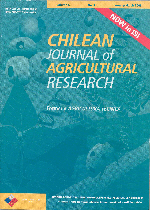
|
Agricultura Técnica
Instituto de Investigaciones Agropecuarias, INIA
ISSN: 0365-2807
EISSN: 0365-2807
Vol. 60, No. 4, 2000, pp. 361-369
|
 Bioline Code: at00032
Bioline Code: at00032
Full paper language: Spanish
Document type: Research Article
Document available free of charge
|
|
|
Agricultura Técnica, Vol. 60, No. 4, 2000, pp. 361-369
| es |
Selectividad de Ovejas en la Utilización de Rastrojo de Trigo Como Alimento
Klee, Germán G.; Pulido, Rubén F. & Chavarría, Jorge R.
Resumen
Se realizó un estudio durante 61 días, con el objeto de evaluar la selectividad de los ovinos cuando se utiliza rastrojo de trigo como único alimento, y cuando se mejora la ración diaria de los ovinos con un concentrado, que corrija en parte las deficiencias de la paja de trigo. El concentrado se suministró a razón de 0,45 kg oveja-1 día-1 y contenía 46,5% avena grano, 6% harina de pescado, 47% afrecho de raps y 0,5% de sales minerales. Se utilizaron 17,14 ha de rastrojo de trigo y 120 ovinos Romney Marsh. El diseño empleado fue bloques completamente al azar, con 60 animales por tratamiento. Se muestrearon fecas en seis ovejas por tratamiento al inicio, mitad y final del experimento, se sometieron a análisis histológico para a determinar la presencia relativa de las especies componentes del rastrojo consumidas por los ovinos. Se efectuaron análisis químico de los componentes del rastrojo para proteína total (PT), fibra detergente ácido (FDA), lignina, cenizas, N, P, K, Mg, Ca, Mn, y Fe. Las ovejas mostraron un alta selectividad de las especies para formular su dieta diaria, y gran habilidad para consumir hierba azul y zarzamora, especies que presentan un evado tenor proteico y mineral. La selectividad no difirió significativamente entre tratamientos (P≥0,05), pero si entre períodos (P≤0,05). Los rangos de contenido de proteína de las especies fluctuaron entre 4,3 y 22,6% base materia seca. Se observó en las fecas predominancia de paja de trigo 29,65% y 26,76%, seguida de hierba azul 23,62% y 23,38%, y zarzamora 21,55% y 28,99%, en los tratamientos sin suplemento y con suplementación, respectivamente.
Palabras-clave
selectividad, rastrojos, alimentación, ovejas
|
| |
| en |
Selectivity of Ewes Grazing on Wheat Stubble
Klee, Germán G.; Pulido, Rubén F. & Chavarría, Jorge R.
Abstract
A study was carried out for 61 days in order to evaluate the selectivity of ewes grazing on wheat stubble with and without a supplement to correct nutritional deficiency. The supplement was offered at a rate of 0.45 kg per ewe per day, composed of: 46.5% oats, 6% fishmeal, 47% rape meal and 0.5 % of minerals. A field of 17.14 hectares of wheat stubble, and 120 Romney Marsh ewes were used. The experimental design was a randomized block, with 60 ewes per treatment. Feces of six ewes per treatment, at the beginning, middle and the end of the experiment were collected in order to make a histological analysis of the relative presence (%) of vegetal species of the stubble consumed by the ewes. Chemical analysis of the stubble was made in order to determine content of total protein (PT), ADF , lignine, ash, N, P, K, Mg, Ca, Mn and Fe. The ewes showed a high selectivity to the species in order to balance the daily ration and great ability to encounter Echium vulgare and Rubus ulmifolius, species with high protein and mineral content. There was no significant difference of selectivity between treatments (P≥ 0.05), but there was a significant difference between periods (P≤0.05). The protein content rate of vegetal species ranged between 4.3 and 22.6 % on a dry matter basis. The following percentages were found in feces: wheat stubble 29.65 % and 26.76 %; Echium 23.62 % and 23.38 %; and Rubus 21.55 % and 28.99% on treatments with and without supplementation, respectively.
Keywords
sheep, selectivity, stubble, feeding
|
| |
© Copyright 2000 - Instituto de Investigaciones Agropecuarias, INIA (Chile)
Alternative site location: http://www.inia.cl/at/agritec.htm
|
|
